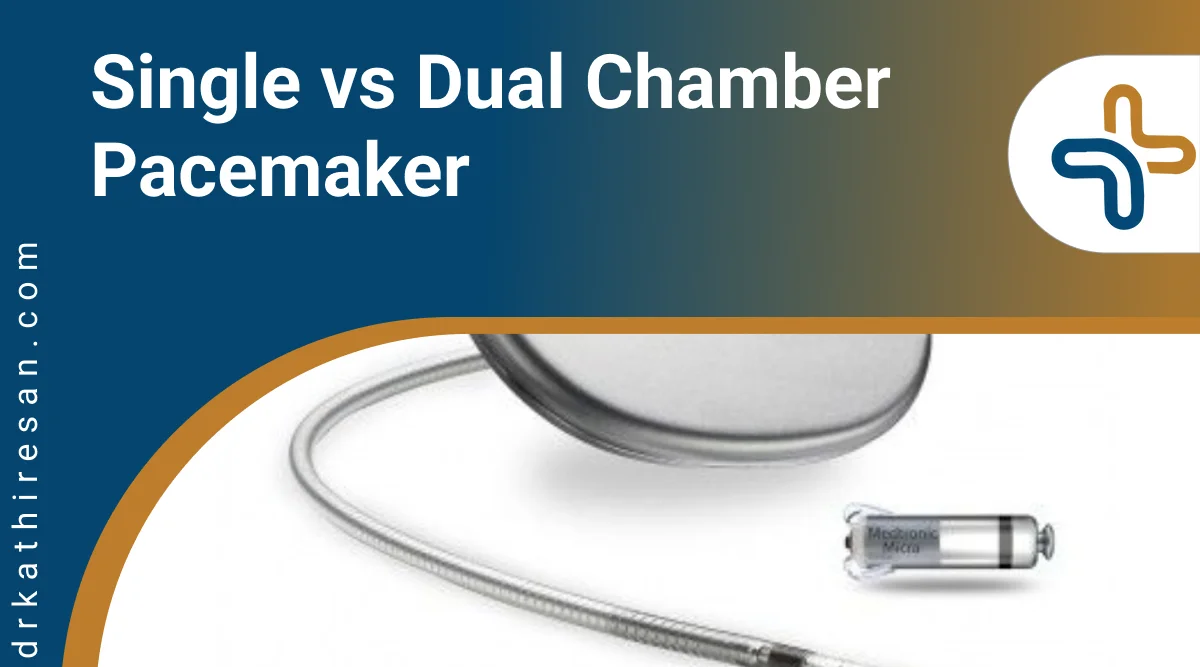Pacemakers are remarkable medical devices designed to regulate the heart’s rhythm and ensure it beats steadily and consistently. They have transformed the lives of countless individuals with heart rhythm disorders. When it comes to pacemakers, two common types are the single chamber pacemaker and the dual chamber pacemaker. In this article, we’ll explore the differences between single vs dual chamber pacemaker and the factors to consider when determining which one may be right for you.
The Basics: What is a Pacemaker?
A pacemaker is an implanted device that monitors your heart’s electrical activity and, when necessary, sends electrical impulses to control the heart rate. It’s commonly used to treat bradycardia, a condition characterized by a slow heart rate, and other heart rhythm disorders.

Single Chamber Pacemaker: Streamlined Simplicity
Before getting to know the difference between single vs dual chamber pacemaker, let us get to know about the single chamber pacemaker in detail.
- Purpose: Single chamber pacemakers, also known as single-chamber pulse generators, have one lead (a thin, insulated wire) that connects to either the right atrium (the upper chamber of the heart) or the right ventricle (the lower chamber of the heart). The choice of chamber depends on the specific needs of the patient and the nature of their heart condition.
- Operation: The single lead in this pacemaker can either pace the atrium or the ventricle, depending on the specific device and the patient’s condition. For instance, if the lead is positioned in the atrium, it monitors and paces the atrium as needed.
- Benefits: While considering single chamber vs dual chamber pacemaker, you should know that single chamber pacemakers are favored for their simplicity. They are relatively straightforward in design and implantation, making them suitable for individuals with certain heart rhythm disturbances, especially those isolated to either the atrium or ventricle.
Dual Chamber Pacemaker: Mimicking Natural Rhythm
On comparing single vs dual chamber pacemakers, a patient should also understand what a dual chamber pacemaker is.
- Purpose: Dual chamber pacemakers, also known as dual-chamber pulse generators, have two leads—one in the right atrium and one in the right ventricle. This design allows for more intricate control of the heart’s rhythm.
- Operation: Understanding the difference of single chamber vs dual chamber pacemaker is essential. Dual chamber pacemakers coordinate the timing of atrial and ventricular contractions, closely mimicking the heart’s natural electrical conduction system. By doing so, they enable a more synchronized heartbeat, which can lead to improved cardiac function.
- Benefits: Dual chamber pacemakers are particularly valuable for individuals with specific heart conditions, such as atrioventricular (AV) block, where the electrical signals between the atria and ventricles are disrupted. These pacemakers can offer a more natural and efficient rhythm.
Comparing Single vs Dual Chamber Pacemaker
Below, we will outline the variations of single vs dual chamber pacemakers.
- Synchronization: One of the fundamental differences between these two types of pacemakers is how they synchronize atrial and ventricular contractions. Dual chamber pacemakers excel in this aspect, providing a rhythm that closely resembles the heart’s natural pattern. In contrast, single chamber pacemakers focus on either the atrium or the ventricle, which can lead to less synchronized contractions.
- Complexity: Single chamber pacemakers are simpler in both design and implantation. They typically require fewer adjustments and are easier to maintain. On the other hand, dual chamber pacemakers are more intricate and may necessitate more frequent monitoring and programming.
- Suitability: The choice between single chamber vs dual chamber pacemaker depends on the nature of the patient’s heart rhythm disorder. Single chamber pacemakers are often appropriate for individuals with isolated atrial or ventricular issues. Dual chamber pacemakers are preferred for conditions that involve both chambers, ensuring a more coordinated heartbeat.
- Battery Life: Dual chamber pacemakers may have slightly shorter battery life compared to single chamber pacemakers. This is because they manage the electrical signals in both the atrium and ventricle, which can consume more energy.
- Cost: Dual chamber pacemakers are generally more expensive than their single chamber counterparts due to their complexity and additional components.
Choosing the Right Pacemaker for You
Selecting the appropriate pacemaker type is a decision best made in consultation with a cardiac electrophysiologist or a cardiologist specializing in heart rhythm disorders. The cardiologist will discuss with you the comparison on single vs dual chamber pacemakers, evaluate your specific condition, medical history, and lifestyle to determine which option aligns with your needs and long-term well-being.
Final Thought
Ultimately, the goal of both single and dual chamber pacemakers is to enhance your quality of life, alleviate symptoms, and ensure that your heart maintains a healthy, well-paced rhythm. Trusting the expertise of your healthcare provider to know the difference of single vs dual chamber pacemakers is a key as they can help you get the right choice for your heart health and overall well-being.
Read Also: Primary Percutaneous Coronary Intervention in Chennai.



